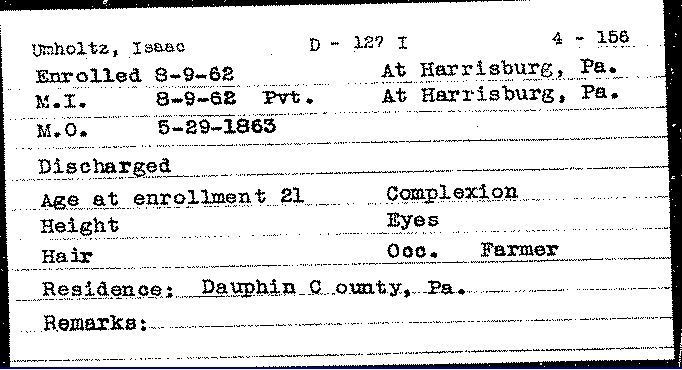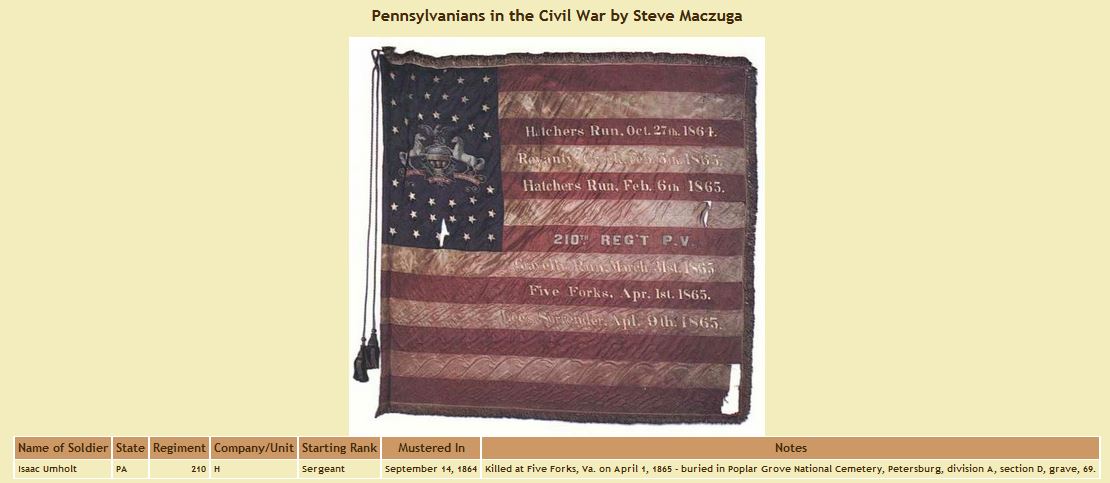The Death of Isaac Umholtz at Five Forks, Virginia
Posted By Norman Gasbarro on November 26, 2014
Isaac Umholtz of Gratz and Lykens Township, Dauphin County, Pennsylvania, was only 17 years old when he enrolled in the 127th Pennsylvania Infantry, Company D, as a Private on 9 August 1862, although he claimed his age was 21. His older brother Emanuel Umholtz stayed at home on the family farm helping the father, Samuel Umholtz (1814-1883). By 29 May 1863, Isaac was discharged from the 127th Pennsylvania Infantry and he returned home in time to help on the farm as Lee approached the Pennsylvania border and an emergency was declared. At the emergency, the older brother Emanuel, who had been part of the Gratztown Militia, went off with his comrades from that group arriving at Gettysburg in time to help with the battlefield clean-up. Then Emanuel returned to the farm in August 1863. Living with the family in 1850 was a 16 year old African American, Edward Crabb, who was working as a laborer. Edward Crabb was also a member of this militia.
Then both brothers again went off to war. Isaac joined the 210th Pennsylvania Infantry, Company H, on 14 September 1864, about seven months after brother Emanuel joined the 9th Pennsylvania Cavalry. Since Isaac had prior service in a regular infantry regiment, he was given the rank of Sergeant.
The 210th Pennsylvania Infantry saw some rough fighting as told by Samuel P. Bates in History of the Pennsylvania Volunteers, 1861-1865:
Soon after its organization, [the 210th Pennsylvania Infantry] was ordered to join the Army of the Potomac, before Petersburg, and was assigned to the Third Brigade, Second Division of the Fifth Corps, where it was associated with the Third and Fourth Delaware, and the remnants of the 190th Pennsylvania Infantry and 191st Pennsylvania Infantry, commanded by General Gwyn.
On 27-28 of October, it was engaged for the first time, at Hatcher’s Run, but suffered only small loss. On 5 December, it moved with the corps on the Bellefield Raid, which lasted for nearly a week, the column destroying the Weldon Railroad as it went, together with station houses, and the stores of the rebel government. The rails were heated, and bent in many fantastic shapes, some of them being twisted into the form of a Maltese Cross, as a certificate of the fact, that it was done by the Fifth Corps. The weather was intensely cold while upon this march, and the troops suffered much, causing many to fall out of the ranks, some of whom were captured and inhumanly murdered. After the return of the column, much sickness prevailed in the regiment, occasioned by the fatigue and exposure to which the troops were subjected, and many died, among them the Chaplain, Reverend Taylor D. Swartz.
In the action near Dabney’s Mills, on the 5-6 February, 1865, the regiment displayed great gallantry, Colonel Sergeant leading with his characteristic heroism and disregard of danger, sustaining considerable losses in killed, wounded, and missing.
On the 27 March, the movement upon Gravelly Run commenced, the 210th Pennsylvania Infantry taking the advance, and during the fierce actions of the three days which succeeded, it was at the fore front, displaying a stubborn bravery, which was unsurpassed, and sustaining losses which unmistakably show the fiery struggle through which it was called to pass. Colonel Sergeant was mortally wounded while gallantly leading his command. Adjutant Morris Schlesinger, a scarred veteran, and Captain John N. Hughes, were also mortally wounded. Schlesinger, when found upon the battle-field, weakened by his wounds, exclaimed, ” this is the death I have sought.” Captain A. T. Kinney was wounded in the throat, and so mangled that he was never after able to speak in an audible tone. Lieutenants William M. Colwell, and John Harding, were also among the wounded. Captain John Cook, and Lieutenant Hosea Hudson, were wounded and taken prisoners. The entire loss was thirty-five killed, one hundred and fifteen wounded, and one hundred and fifty missing.
The command now devolved upon Lieutenant Colonel Witman, who was subsequently commissioned Colonel, and under him, the regiment participated in the fierce fighting of 1 April, taking flags, small arms, and prisoners. In a charge made upon the enemy’s works, it displayed its wonted courage, sustaining heavy losses in killed and wounded…
It was there on the field at Five Forks, Virginia, on 1 April 1865 that Isaac Umholtz lost his life, one of the many casualties of that day’s fighting.
According to information in some records, Isaac Umholtz is buried at Poplar Grove National Cemetery, Petersburg, Virginia (Division A, Section D, Grave 69). He does not have a Findagrave Memorial and a picture of his grave marker has not been seen.
The surviving brother, Emanuel Umholtz, was notified of his brother’s death while he was serving with the 9th Pennsylvania Cavalry.
No Pension Index Card has been located for Isaac Umholtz indicating that no close relative qualified to receive benefits for his sacrifice.
Additional information is sought on this soldier from the Lykens Valley who died in the Civil War. Comments can be added to this post or sent by e-mail.
—————————–
The screen capture of the regimental flag and military information is from Steve Maczuga’s web site, Pennsylvanian in the Civil War. The Pennsylvania Veterans’ File Card (top of post) is from the Pennsylvania Archives.
 ;
;




Comments